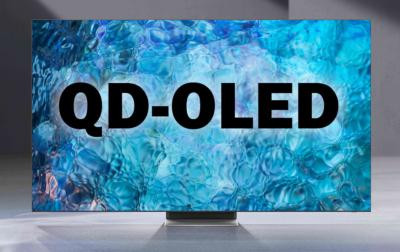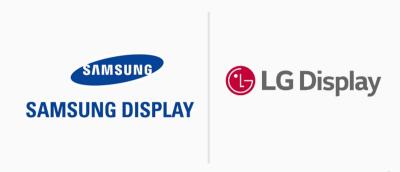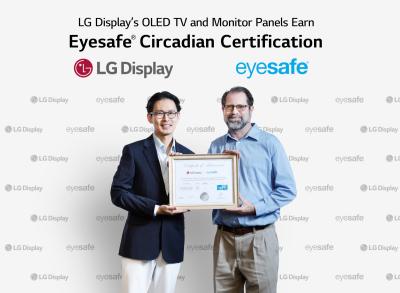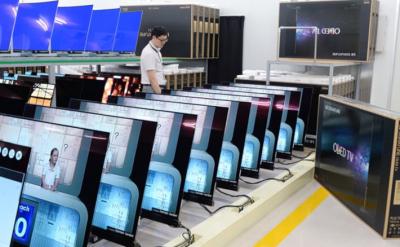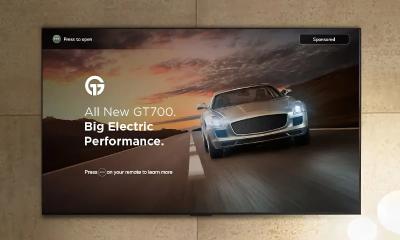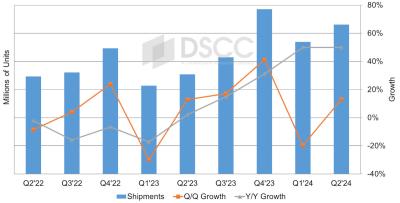OLED TV: Introduction and Industry News
What is an OLED TV?
OLED TVs use a display panel technology called OLED (Organic Light Emitting Diodes). Compared to LCDs, OLEDs offer an improved image quality, and are brighter, more efficient, and thinner. Simply put, OLED TVs deliver the best picture quality ever!
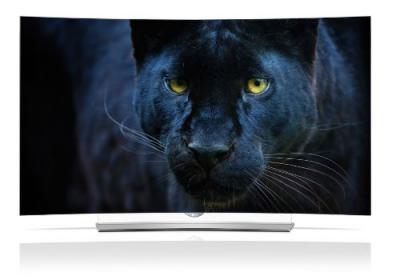
OLED TV technology
Each pixel in an OLED TV emits light on its own (in fact each pixel is made from 3 different OLEDs, red, green and blue). OLEDs are truly emissive devices with a simple design which gives them many advantages over current LCD technology:
- High contrast: in OLEDs we have true blacks as when a pixel is off it does not emit any light. In LCDs, the backlighting is always on and so true blacks are impossible to achieve. Even when compared to the latest high-end mini-LED backlit LCDs, the contrast of OLEDs is superior.
- High refresh rates: OLEDs can switch on and off much faster than LCDs.
- Better power consumption: OLEDs only consume light on lit pixels - as opposed to LCDs who always need to use the backlighting. The power consumption of OLEDs depends on the image shown, but in most cases OLEDs will be more efficient than LCDs.
- Flexibility: the simple design of OLEDs enables next-generation flexible, bendable, foldable and even rollable displays.
Click here for a more in-depth comparison between LCDs and OLEDs.
OLED TVs on the market - what can you buy today?
The leading OLED TV panel producer is LG Display - making panels ranging from 42-inch to 97-inch. These OLEDs offer the best image quality of all TVs on the market today. LGD is offering its OLED panels to many companies, including LG Electronics, Sony, Vizio and Panasonic.
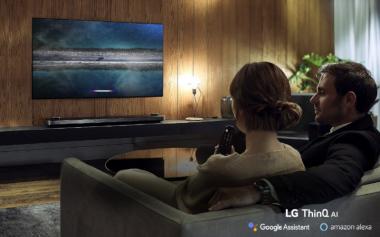
In 2022 Samsung joined LGD and started to produce its own OLED TV variant, called QD-OLED (which is based on blue OLED emitters and quantum dots color conversion technology). QD-OLED panels offers a superb image quality, but Samsung's production capacity is smaller than LG's.
Today close to 10 million OLED TVs ship every year, from many TV producers (including LG, Samsung, Sony, Panasonic, Philips and more), offering a wide range of OLED TV models. Click here for the latest OLED TVs on the market.
Reviews of OLED TVs are terrific, and most experts and consumers agree that these OLED TVs are the best TVs ever produced - with virtually perfect image quality and beautiful form factors.
Direct Emission vs WRGB / QD-OLED
The most straightforward OLED architecture uses 3 color OLED sub-pixels (Red, Green and Blue) to create each 'pixel'. This is referred to as a direct emission OLED, and is the design used in mobile OLED displays (for example those used in Apple's latest iPhones, iPads and Watches). But direct-emission OLEDs are not available in TV sizes (not yet, anyway).
For its OLED TVs, however, LG Display uses a different architecture, called WRGB (or WOLED-CF) which uses four white OLED subpixels (each created by using both blue and yellow OLED emitters) with color filters on top (RBG and W). The WRGB technology (developed by Kodak many years ago and now owned by LG Display) was found to be easier to scale-up for large-area OLED production, although it suffers from lower efficiency and more complicated design compared to direct-emission TVs .
As we stated, Samsung's OLED TV architecture is based on blue OLED emitters and quantum-dots color conversion layers. In terms of performance, this architecture seems to be rather similar to LGD's WRGB panels.
Further reading
- Introduction to OLEDs
- A list of all OLED TVs on the market
- OLED vs LED TVs
- Flexible OLEDs
- The OLED Toolbox, OLED industry guides, insights, data and more!
Omdia: large-area OLED panel shipments to frow 116.5% in 2024, and 32.7% in 2025
Omdia estimates that shipments of OLEDs over 9-inch in size (which Omdia defines as large-area OLEDs, although most companies will refer to these sizes as medium-sized OLEDs) will increase 116.5% in 2024, and will rise a further 32.7% in 2025.
This growth is driven by increasing demand for OLED monitors, tablets and laptops.
Applied Materials launches a maskless OLED production technology, to support 8-Gen high efficiency OLED deposition and encapsulation
Applied Materials announced a technology, branded as MAX OLED that enables OLED display production on large glass substrates, aiming to provide a cost-effective solution to produce TV and TV displays. Applied developed and patented a new OLED pixel architecture and a "dramatically different manufacturing approach" that the company says enables brighter, clearer, more energy-efficient and longer-lasting.
Applied's new MAX OLED systems can scale from 6-Gen substrates to 8-Gen substrates, supporting the new wave of IT OLED production lines. Applied says that its new solution has strong customer interest - and already achieved repeat orders from several leading display makers (see below). Specifically, Applied announced that it will supply an R&D system to Samsung Display that will test the new production technology for its AMOLED and QD-OLED production technologies.
Samsung may launch 83-inch QD-OLED TVs in 2025
According to reports, based on information found on a parts database, Samsung Electronics is getting ready to launch a 83-inch QD-OLED TV in 2025. The 83-inch panel will be introduced in the 2025 QD83S9F TV, and Samsung us likely to use both WOLED and QD-OLED panels in this TVs as was done in the 2024 S90D.
This is interesting news. Samsung's QD-OLED technology is under pressure and it is not clear whether Samsung intends to continue investing in it, and expanding production capacity. It seemed as if SDC is mostly focused on gaming monitors, but perhaps now it is also expanding its TV panel range, which is a welcome change.
LGD's WOLED panels feature the highest color accuracy in the display industry, according to a new IEC standard
LG Display announced that the International Electrotechnical Commission (IEC) has adopted its “color perception difference measurement method” as an international standard. According to the new standard, LG Display’s large-sized OLED panels have high color accuracy, with a color perception difference of only about 10%, the lowest in the industry.
LG Display explains that in this context, differences in color perception refer to a phenomenon in which different viewers perceive the same color differently when it is shown on a display, resulting in color distortion. It is mainly caused by viewers’ visual characteristics, but the difference can be greater depending on the type of display. For example, the same white color can be perceived by different viewers to have either a blue or yellow tone.
Does it make sense for LG Display and Samsung Display to merge?
In this article, we examine the theoretical question of whether or not it makes sense for LG Display and Samsung Display to merge, into one company.
Note that we have no indications that such a merger is even considered by the two companies, but we feel this is a fascinating topic that should be explored, and is supported by several strong arguments.
We'll start with a short introduction to the two companies, then see why there are many reasons to pursue a merger, then explain the reasons against a possible merger, and finally detail the current financial situations of both companies.
Samsung Display and LG Display
Samsung Display Corporation (SDC) is a subsidiary of Samsung Electronics. SDC is a leader in OLED production, with a market share of over 40% in the small OLED display market (the second largest player, BOE, holds a market share of around 15%). SDC produces over 300 million AMOLED displays per year - supplying them to Apple's iPhones and tablets, Samsung Electronics Galaxy phones, and many more. The Company also produces larger-area QD-OLED panels for TVs and gaming monitors, and has a capacity of producing around a million TV panels per year. SDC no longer produces any LCDs. SDC does produce microLED displays (but on a very small scale, this is currently a strictly next-gen display technology), and the company develops OLED microdisplays (and also holds OLED microdisplay producer eMagin which it acquired in 2023 for $243 million).
LG Display's WOLED panels receive Eyesafe's Circadian Certification
LG Display announced that its entire lineup of OLED TV and monitor panels, from 27 to 97 inches (all of its WOLED panels), have become the world’s first displays to receive Eyesafe Circadian Certification. LG Display’s OLED TV and monitor panels achieved the highest circadian certification rating (CPF 50).
EyeSafe, a US-based company specializing in blue light mitigation solutions, says that LG's OLED panels are promoting eye health and better sleep, as the emit just 36% blue light, the lowest in the industry.
OLED TVs - is there a path towards increased production capacity?
OLED TVs offer excellent image quality, outperforming LCDs with superb contrast, excellent and vivid color reproduction and fast refresh rates. In addition, OLEDs enable thin and efficient TVs. OLED TV production has been increasing up until a year ago, reaching a potential capacity of around 10 million units. This is impressive, but considering the entire global TV market that amounts to around 250 million units, OLEDs represent only around 2.5% of the total market (it is important to note that OLEDs tend to be produced in large sizes and carry a much higher average selling price compared to LCDs).
But OLED TV production capacity growth has declined in recent years. In this article we will shortly detail the history of OLED TV production, and look at potential paths towards increased penetration in the future. More details and into the future of OLED technologies and OLED TVs is included in the OLED Toolbox.
A bit of history: in 2013, both Samsung and LGD started producing OLED TV panels. Samsung chose the straightforward RGB side-by-side architecture, in which there are three sub-pixels, with red, green and blue OLED emitters. LG chose its own WRGB (or WOLED) architecture (the IP was acquired from Kodak in 2009) which uses four white OLED subpixels (made from yellow and blue OLED subpixels). Both companies released 55" FHD OLED TVs, priced at over $10,000 per unit. It soon became clear that Samsung's approach was not scalable, while LGD managed to enter mass production quickly and reduce prices dramatically within a few years to compete with the dominant LCD TV technology.
LG to launch screensaver ads on OLED TVs, do owners need to worry about lifetime and burn-in?
LG Electronics is going to add screensaver ads to its TVs, including its high-end OLED TV range. It seemed the company has already started testing this new feature, which shows full-screen ads, and the company will offer a way to turn the ads off, as it markets the new ad system a "feature".
LG Ad Solutions company announced the new "Native Screensaver Ads" feature, that "capitalizes on idle screen time, turning what may be perceived as a period of downtime into a valuable engagement opportunity".
Three former senior researchers from LG Display are accused of sealing OLED trade secrerts
According to reports from Korea, three former senior researchers at LG Display are accused of passing OLED trade secrets to a Chinese panel maker. The Seoul District Prosecutor office says that the there researchers took photos of designs at LGD's Guangzhou factor in 2021 and 2022, related to large-area WOLED panel production processes.
One of the suspects started working for a large China-based display company in 2021, and he allegedly colluded with a former LG Display employee to steal large-scale OLED panel mass production technology.
DSCC: OLED panel shipments jumps 50% in Q2 2024
According to DSCC, OLED panel shipments increased 50% in the second quarter of 2024, compared to the second quarter of 2023. Compared to the previous quarter, shipments increased 13%.
DSCC says that OLED tablet shipments increased 356% in the quarter compared to last year (led by Apple's adoption of AMOLEDs in its iPad Pro devices). OLED smartphone spanel shipments also 49%, while OLED TV panel shipments increased 30% from 2023.
Pagination
- Page 1
- Next page


